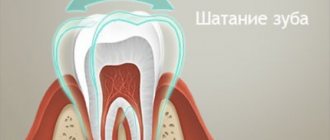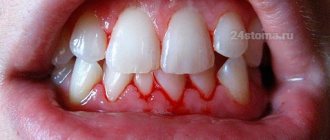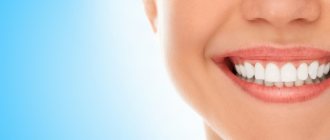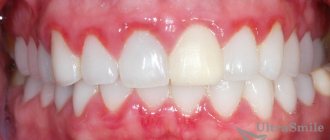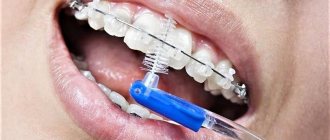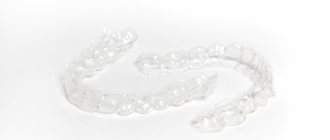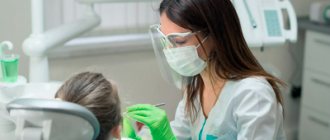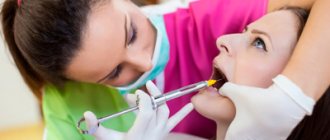For gum inflammation, doctors recommend a comprehensive approach to treatment. One effective option is the use of collagen plates, such as those produced by Farmadont. This product is unique and has no analogues; it contains collagen and natural plant components. According to patient reviews, positive dynamics are observed after the course of treatment. The plates are approved for use at any age. We will consider in more detail about the types and method of application below.
What are they needed for?
Dentists recommend using plates in the following cases:
- Gingivitis.
- Periodontitis.
- Bleeding gums.
- Periodontal disease.
- Injuries and damage to gums.
- Recent surgery, such as tooth extraction or implantation. Active components allow you to speed up the process of tissue regeneration.
The only contraindications can be identified as an allergic reaction. It is manifested by severe itching and increased swelling. In this case, you should thoroughly rinse your mouth with an antiseptic solution and stop treatment with Farmadont. Carefully study the composition before using the plates. Before use, consultation with a specialist is recommended.
When can and cannot be used Mucograft?
I really like one of A. C. Clark's laws, which states that:
Over the course of ten years of working with the Geistlich Mucograft collagen matrix, we have tried to find the limits of its capabilities and thus form a range of indications for its use. And this is what we got:
Vestibuloplasty (deepening of the vestibule of the oral cavity)
The operation described in this article is the main reason for using Mucograft collagen matrices.
We use 98 out of 100 packages of Mucograft for vestibuloplasty in the area of teeth and/or implants:
The relevance of using collagen matrices increases during extensive and extended operations, while for minor (within 1-2 teeth) traumatic interventions, its use is not advisable from a financial point of view - the operation turns out to be too expensive.
Gum recession plastic surgery
The Geistlich Pharma company claims that plastic surgery for gum recession is one of the indications for the use of Mucograft collagen matrices. I find this statement not only controversial, but even contrary to the properties of the specified material. And that's why.
Firstly, when performing gum plastic surgery using the coronal flap displacement method (as, in fact, any other method), the use of a free connective tissue graft (CTG) is intended to change the thickness (biotype) of the gum adjacent to the tooth root. Mucograft is not capable of changing the biotype; its purpose is completely different - to increase the width.
Secondly, Mucograft does not in any way contribute to the “fusion” of the displaced mucosa with the tooth root. In my opinion, all those clinical problems where Mucograft was used to correct gum recession could have been solved without it - the result would have been exactly the same, and perhaps even better.
Thirdly, plastic surgery for gum recession in the area of one tooth is a trivial and very cheap operation. The use of a collagen matrix increases its cost at least twice. And if from a medical point of view the use of Mucograft is controversial, then from a financial point of view it is categorically not advisable.
Of course, if the doctor has a mortgage and a car loan, then you can use Mucograft everywhere and in any conditions, but if instead of a credit BMW and a mortgaged two-room apartment in Zilart, the dentist has a mind, then he will refuse to use collagen matrices for plastic surgery of single recessions.
In other words, I would caution against attempting to use Mucograft to repair gum recession. If only because I did not see good results in the long term (more than 5-10 years).
Preservation of the hole
You can read more about this operation here>>
I have no questions about the use of collagen matrices for graft isolation during socket preservation after extraction. In all respects, this does not contradict either common sense or the declared properties of Mucograft:
The need for such intervention raises much more questions for me - in my opinion, currently the indications for it are excessive and in most cases not justified. To specify them, you need to at least minimally understand the mechanisms of development of the atrophic process - but who delves into this? (((….
Closing perforation of the maxillary sinus mucosa during sinus lift
This version of the “non-canonical” use of Mucograft is described here>> or here>>, in an article devoted to complications of sinus lifting. I recommend reading it.
From the point of view of the known properties of collagen matrices and what we know about the microflora and structure of the maxillary sinuses, I find the use of Mucograft Seal to close perforations during sinus lifting not only justified, but expedient both from a medical and financial point of view (Mucograft Seal is cheaper any Geistlich barrier membrane).
Moreover, such tactics work in the case of very large perforations, when the Schneiderian membrane “tears into a British flag.” You just need to take a larger Mucograft.
How to use it correctly
The plates are very easy to use:
- First, carry out a complete hygienic treatment of the oral cavity. Brush your teeth with toothpaste and a brush, use dental floss, mouthwash and irrigator.
- Wash your hands thoroughly with soap. Lightly massage your gums using your fingertips for 2-3 minutes.
- Then take the packaging and remove the plate.
- Remove the protective film and apply the product to the gum, firmly fixing and straightening the plate with your fingers.
- Close your jaws and wait for complete dissolution. It usually takes about 10 minutes, after which the plate dissolves on its own.
After the procedure, it is not recommended to eat or drink water for 1.5 hours. Depending on the specific diagnosis and severity of the pathological process, the doctor can establish an individual course of treatment. It is usually recommended to use the drug twice a day for 7-10 days. It is convenient to use the plates at night, in which case the therapeutic effect remains for a longer time.
The drug for the treatment of gums is affordable; it can be found in almost any pharmacy. The price is very reasonable; on average, a pack of plates (24 pieces) does not exceed 400 rubles.
Collagen plates for gums FARMADONT I
Collagen plates for gums FARMADONT I (Farmadont 1) are intended for the prevention and treatment of inflammatory and other gum diseases at any stage in children and adults. Collagen plates Farmadont I ─ is a combined preparation consisting of cosmetic and natural collagen and medicinal plant extracts.
Used for inflammation in the oral cavity. Collagen plates are an effective way to prevent diseases of oral tissues, such as gingivitis, alveolitis, and periodontitis. They are used at any stage of the disease, suitable for both adults and children. The components included in the plate have a healing effect, relieve inflammation, cleanse tissues of non-viable elements, strengthen blood vessels and stabilize local immunity.
Ingredients: cosmetic collagen, extracts of maclea, sage, rose hips, chamomile, ichthyokol (dry crushed collagen from the swim bladders of sturgeon and large catfish), crab collagenase. To eliminate painful sensitivity of teeth and gums in children and adults. The components included in the plate have a healing effect, relieve inflammation, cleanse tissues of non-viable elements, strengthen blood vessels and stabilize local immunity. Packing: 24 plates.
Collagen plates for gums FARMADONT I (Farmadont 1) price: 336.00 rub.
Healing properties: strengthen weak gums, eliminate bleeding, soothe pain, reduce sensitivity, provide antimicrobial and antibacterial protection, promote healing of the mucous and soft tissues of the oral cavity. The action of the active components of Farmadont I collagen plates for gums: Collagen is a “building material” necessary for the healing and restoration of soft tissues of the oral cavity. Relieves inflammation, stops bleeding, serves as a source of nutrients. Stimulates the synthesis of its own collagen in tissues. Macleay extract has antibacterial and antimicrobial activity, an antagonist of yeast-like and filamentous fungi. Active against microorganisms that are insensitive to antibiotics. Sage extract contains essential oil, flavonoids, tannins, vitamins P and PP, which together provide anti-inflammatory, antimicrobial and astringent effects. Rosehip extract is a multivitamin with a high content of vitamins C, K, rutin, carotene, as well as potassium, iron, manganese, phosphorus, calcium, magnesium, tannins. It has a vascular strengthening effect and increases local immunity. Chamomile extract is an antiseptic given by nature. Chamomile has an anti-inflammatory, hemostatic and analgesic effect, eliminates irritation, softens, and reduces the likelihood of allergic reactions.
The use of collagen plates for gums for inflammation of Farmadont I does not require special skills. Farmadont plates are safe if accidentally swallowed.
Directions for use: Carry out oral hygiene, brush your teeth. With dry, clean hands, remove the plate from the packaging. Apply and carefully straighten the plate along the gums, pressing lightly. The plate itself is fixed to the wet gum. Over time, the plate dissolves in the oral cavity. Before re-application, remove any remaining plates. Do not eat or drink until the plates have dissolved or until the remains of the plate have been removed from the mouth. Use for 1-2 weeks, depending on the intensity of the pathological process, until symptoms disappear permanently. , Russia. Shelf life: 3 years.
How does the process of installing records work?
The plates are installed on the teeth simply and quickly, it does not cause any pain. The design is made individually. Before this, the specialist conducts an X-ray examination, takes an impression, and creates a plaster model that will match the patient’s shape. The base of the plate should follow the surface of the gums, its relief, as well as the dental contour. And with the help of an arc, the position of the structure is already fixed. Most often, the plate is placed on baby teeth. After all, in children the dental system is not formed, so it will be easier for them to correct their dentition.
Quite often you can find plates for teeth in orthodontics. After all, this method is considered more gentle for children in the matter of correcting their bite. And the plates are cheaper than braces.
It is important to remember that the most important thing is to seek help from a professional in time! He will tell you how best to correct the existing defect, which method will be most effective and when you can use it.
Are there any difficulties?
According to reviews, dental plates are effective, but in the case of children there is one problem. It lies in the fact that you need to wear them at least 22 hours a day for 12 to 18 months. This does not always please young patients who are not delighted with the presence of a structure on their teeth, which requires getting used to and which may cause teeth pain at first.
It is important to explain to the child that plates are much less noticeable than braces, which will have to be worn if the plate does not give the desired effect... And to achieve the effect, you need to use it correctly. It is better to undergo a much simpler course of treatment now than to resort to much more complex treatment in adolescence - especially since the result will be obvious! The child needs to be taught:
- Wear the plate in the morning;
- Remove the plate to brush your teeth before going to bed;
- Do not remove the system during the day;
- Tighten the structure screw in a timely manner.
Types of records
Plates are special orthodontic structures that are necessary to prevent changes in the shape of the jaw bone, displacement of teeth, fix teeth in a certain position, and cure malocclusion. The plate does not move the teeth, it simply holds them in place. Therefore, it is often used when just starting to correct an incorrect bite. Then, instead of the plate, braces are installed. Compared to the braces system, the plate can be removed if necessary. There are the following types of dental plates:
- Removable plates. It is made of plastic, contains chemical and completely safe components. In addition, there are metal hooks, springs, and screws, which are considered additional. Using this type of plate, you can correct a number of teeth, but only slightly. This structure can be installed both from above and from below;
- Fixed plates. It is attached to the outer surface of the teeth; for this purpose there is a special system of locks. An arc is passed through them, which pulls all the locks in a specific direction. This plate allows you to straighten teeth regardless of the patient’s age, correct dental deformations, and remove gaps formed between teeth.
